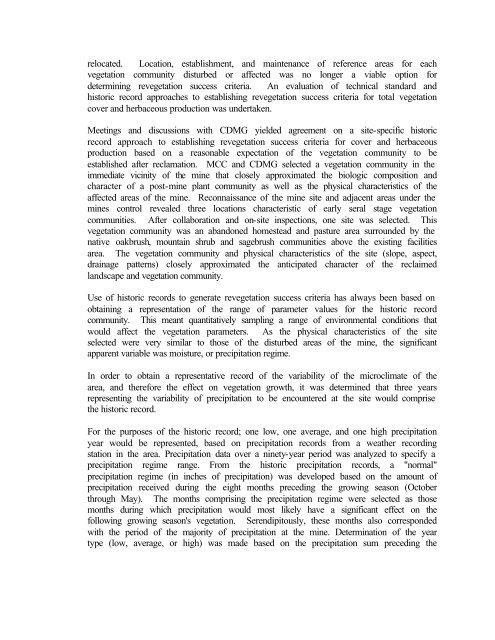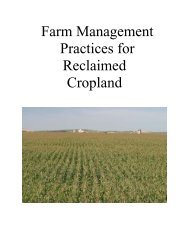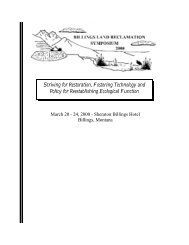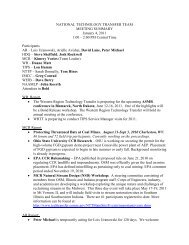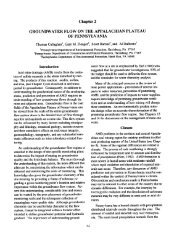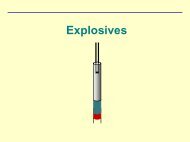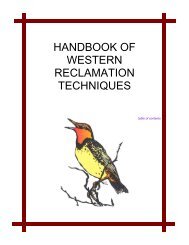Revegetation - OSM Technology Transfer - Office of Surface Mining
Revegetation - OSM Technology Transfer - Office of Surface Mining
Revegetation - OSM Technology Transfer - Office of Surface Mining
Create successful ePaper yourself
Turn your PDF publications into a flip-book with our unique Google optimized e-Paper software.
elocated. Location, establishment, and maintenance <strong>of</strong> reference areas for each<br />
vegetation community disturbed or affected was no longer a viable option for<br />
determining revegetation success criteria. An evaluation <strong>of</strong> technical standard and<br />
historic record approaches to establishing revegetation success criteria for total vegetation<br />
cover and herbaceous production was undertaken.<br />
Meetings and discussions with CDMG yielded agreement on a site-specific historic<br />
record approach to establishing revegetation success criteria for cover and herbaceous<br />
production based on a reasonable expectation <strong>of</strong> the vegetation community to be<br />
established after reclamation. MCC and CDMG selected a vegetation community in the<br />
immediate vicinity <strong>of</strong> the mine that closely approximated the biologic composition and<br />
character <strong>of</strong> a post-mine plant community as well as the physical characteristics <strong>of</strong> the<br />
affected areas <strong>of</strong> the mine. Reconnaissance <strong>of</strong> the mine site and adjacent areas under the<br />
mines control revealed three locations characteristic <strong>of</strong> early seral stage vegetation<br />
communities. After collaboration and on-site inspections, one site was selected. This<br />
vegetation community was an abandoned homestead and pasture area surrounded by the<br />
native oakbrush, mountain shrub and sagebrush communities above the existing facilities<br />
area. The vegetation community and physical characteristics <strong>of</strong> the site (slope, aspect,<br />
drainage patterns) closely approximated the anticipated character <strong>of</strong> the reclaimed<br />
landscape and vegetation community.<br />
Use <strong>of</strong> historic records to generate revegetation success criteria has always been based on<br />
obtaining a representation <strong>of</strong> the range <strong>of</strong> parameter values for the historic record<br />
community. This meant quantitatively sampling a range <strong>of</strong> environmental conditions that<br />
would affect the vegetation parameters. As the physical characteristics <strong>of</strong> the site<br />
selected were very similar to those <strong>of</strong> the disturbed areas <strong>of</strong> the mine, the significant<br />
apparent variable was moisture, or precipitation regime.<br />
In order to obtain a representative record <strong>of</strong> the variability <strong>of</strong> the microclimate <strong>of</strong> the<br />
area, and therefore the effect on vegetation growth, it was determined that three years<br />
representing the variability <strong>of</strong> precipitation to be encountered at the site would comprise<br />
the historic record.<br />
For the purposes <strong>of</strong> the historic record; one low, one average, and one high precipitation<br />
year would be represented, based on precipitation records from a weather recording<br />
station in the area. Precipitation data over a ninety-year period was analyzed to specify a<br />
precipitation regime range. From the historic precipitation records, a "normal"<br />
precipitation regime (in inches <strong>of</strong> precipitation) was developed based on the amount <strong>of</strong><br />
precipitation received during the eight months preceding the growing season (October<br />
through May). The months comprising the precipitation regime were selected as those<br />
months during which precipitation would most likely have a significant effect on the<br />
following growing season's vegetation. Serendipitously, these months also corresponded<br />
with the period <strong>of</strong> the majority <strong>of</strong> precipitation at the mine. Determination <strong>of</strong> the year<br />
type (low, average, or high) was made based on the precipitation sum preceding the


